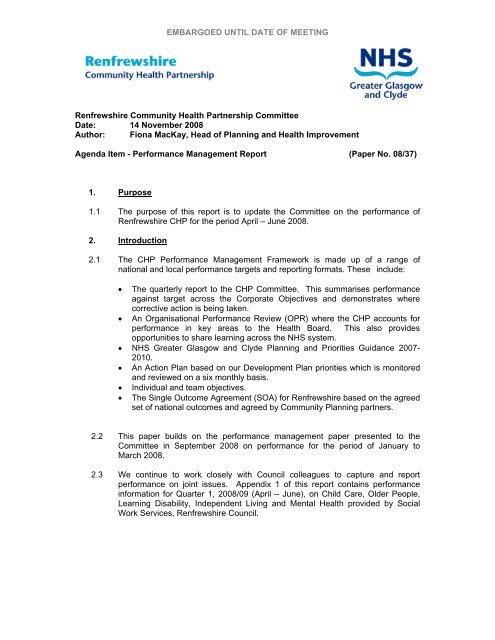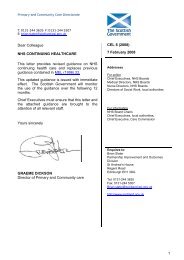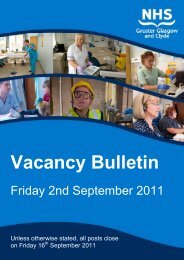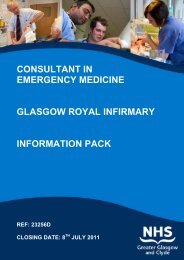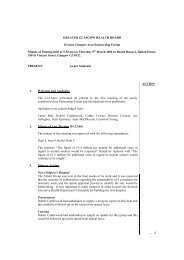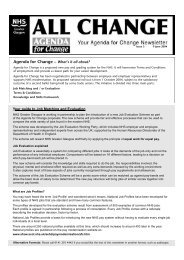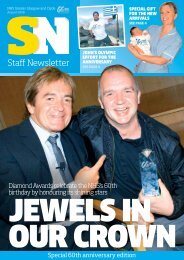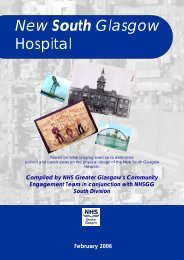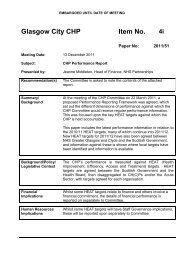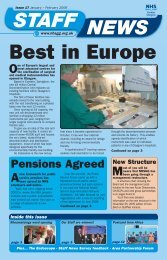CHP Performance Report - April - June 2008 - NHS Greater ...
CHP Performance Report - April - June 2008 - NHS Greater ...
CHP Performance Report - April - June 2008 - NHS Greater ...
Create successful ePaper yourself
Turn your PDF publications into a flip-book with our unique Google optimized e-Paper software.
EMBARGOED UNTIL DATE OF MEETINGRenfrewshire Community Health Partnership CommitteeDate: 14 November <strong>2008</strong>Author: Fiona MacKay, Head of Planning and Health ImprovementAgenda Item - <strong>Performance</strong> Management <strong>Report</strong> (Paper No. 08/37)1. Purpose1.1 The purpose of this report is to update the Committee on the performance ofRenfrewshire <strong>CHP</strong> for the period <strong>April</strong> – <strong>June</strong> <strong>2008</strong>.2. Introduction2.1 The <strong>CHP</strong> <strong>Performance</strong> Management Framework is made up of a range ofnational and local performance targets and reporting formats. These include:• The quarterly report to the <strong>CHP</strong> Committee. This summarises performanceagainst target across the Corporate Objectives and demonstrates wherecorrective action is being taken.• An Organisational <strong>Performance</strong> Review (OPR) where the <strong>CHP</strong> accounts forperformance in key areas to the Health Board. This also providesopportunities to share learning across the <strong>NHS</strong> system.• <strong>NHS</strong> <strong>Greater</strong> Glasgow and Clyde Planning and Priorities Guidance 2007-2010.• An Action Plan based on our Development Plan priorities which is monitoredand reviewed on a six monthly basis.• Individual and team objectives.• The Single Outcome Agreement (SOA) for Renfrewshire based on the agreedset of national outcomes and agreed by Community Planning partners.2.2 This paper builds on the performance management paper presented to theCommittee in September <strong>2008</strong> on performance for the period of January toMarch <strong>2008</strong>.2.3 We continue to work closely with Council colleagues to capture and reportperformance on joint issues. Appendix 1 of this report contains performanceinformation for Quarter 1, <strong>2008</strong>/09 (<strong>April</strong> – <strong>June</strong>), on Child Care, Older People,Learning Disability, Independent Living and Mental Health provided by SocialWork Services, Renfrewshire Council.
3. <strong>Performance</strong> Management <strong>Report</strong> (<strong>April</strong> - <strong>June</strong> <strong>2008</strong>)3.1 From <strong>April</strong> <strong>2008</strong>, the performance targets are categorised under <strong>NHS</strong>GGC’sseven Corporate Objectives:• Improve Access• Shift the Balance of Care• Improve Individual Health Status• Focus Resources on Greatest Need• Be an Effective Organisation• Improve Resource Utilisation• Modernise Services3.2 There are 55 performance indicators included in this report, of which 26 areassessed using the traffic light reporting system, which measures the <strong>CHP</strong>’scurrent status against each of the performance targets. There are fewerindicators assessed using the traffic light reporting system in this first quarterreport for <strong>2008</strong>/09 than in previous reports, as baselines and measurementprocesses are still developing. Where possible the indicators show short andlong term trends. In line with <strong>NHS</strong>GGC’s reporting, a number of targets that the<strong>CHP</strong> has achieved and continue to show green status have been removed.3.3 A number of previously reported health improvement HEAT (HealthImprovement, Efficiency, Access and Treatment) targets are deleted from <strong>April</strong><strong>2008</strong> as the HEAT targets have been reviewed nationally. We have also deletedtargets which have proved difficult to accurately measure and show very little, ifany, improvement in the shorter-term, e.g. % of people drinking excessively,% of people exercising, % of adults overweight (most recent data available fromYour Health and Wellbeing Survey, 2001). Two of the new targets are to ‘achieveagreed completion rates for child healthy weight intervention programmes by2010/11’, and ‘achieve agreed number of screenings using the settingappropriatescreening tool and appropriate alcohol brief intervention, in line withSIGN 74 guidelines by 2010/11’. Measures and targets for Renfrewshire have stillto be defined across <strong>NHS</strong> <strong>Greater</strong> Glasgow and Clyde and these will be includedin future reports once the information is available.3.4 Additional new targets included in this report include paediatric occupationaltherapy waits over 18 weeks, smoking cessation rates, % GP referrals to hospitallocations received electronically, and achieving agreed improvements in the earlydiagnosis and management of patients with dementia by March 2011.3.5 As would be expected with new targets, the <strong>CHP</strong>’s performance against them iscurrently showing red status in the traffic light reporting system. These newtargets, particularly in the area of health improvement, will prove challenging tomeet by the proposed target dates. Work is ongoing within the <strong>CHP</strong> and across<strong>Greater</strong> Glasgow and Clyde to improve the quality of data collected in order toaccurately measure performance against these targets.
3.6 Table 1 summarises progress from the previous four quarters, <strong>June</strong> 2007,September 2007, December 2007 and March <strong>2008</strong>. 58% of our indicators haveGreen or Amber status at 30 <strong>June</strong> <strong>2008</strong>.Table 1PeriodNo. of Green Amber RedindicatorsApr – <strong>June</strong> ‘07 45 19 (42%) 18 (40%) 8 (18%)July – Sept ‘07 46 17(37%) 16(35%) 13 (28%)Oct – Dec ‘07 46 19 (41%) 16 (35%) 11 (24%)Jan – Mar ‘08 61 24 (39%) 23 (38%) 14 (23%)Apr – <strong>June</strong> ‘08 26 6 (23%) 9 (35%) 11 (42%)Indicators which moved positively since the last quarter include waiting times forOlder Adults Community Mental Health Services, % of 3-5 year olds registeredwith an <strong>NHS</strong> dentist across <strong>Greater</strong> Glasgow and Clyde, and reducing the annualrate of increase of daily defined dose (DDD) per capita of anti-depressants.Indicators that moved negatively, from green to amber include – delayeddischarges and waiting times for dietetics, and from amber to red – exclusivebreastfeeding rates. Waiting times for Speech and Language Therapy (SLT) andPodiatry services moved from green status at March <strong>2008</strong> to red status at <strong>June</strong><strong>2008</strong>.3.7 Areas where performance is significantly below target in Renfrewshire include:• Physiotherapy waits over 5 weeks for routine appointments• Paediatric Occupational Therapy waits over 18 weeks• Breastfeeding rates• <strong>CHP</strong> staff sickness absence rateAreas where performance is on target or close to target include:• Dietetic waits over 6 weeks• Older Adult Community Mental Health waits over 6 weeks• Antidepressants per capita (age 15+)• 95% target for all childhood vaccinations• Financial targets3.8 The traffic light reporting system used to assess the <strong>CHP</strong>’s current status againsteach of the performance targets shows:• Green – on target or better• Amber – adverse variance of up to 10%• Red – adverse variance of more than 10%When analysing trends in the data, the report uses the following measures:• No change – within 5%• Better – improvement of 5% or more• Worse – reduction of 5% or more
3.9 Status is determined either by comparison of actual performance against aspecific target/milestone or by comparison of reported short and long-termtrends against the target direction. The status is described within the report.3.10 The <strong>Performance</strong> Management <strong>Report</strong> is based on an assessment of availablekey targets and standards. Section 10 includes additional information on ChildProtection and Access to GP Surgeries.4. Benchmarking Across <strong>NHS</strong>GGC4.1 From <strong>April</strong> <strong>2008</strong>, a corporate <strong>Performance</strong> Management <strong>Report</strong> is produced on aquarterly basis by the Head of <strong>Performance</strong>, <strong>NHS</strong>GGC. The report containsinformation on eleven key targets and shows performance data across the tenCHCP/<strong>CHP</strong>s in <strong>Greater</strong> Glasgow and Clyde. This is a form of exception reportingand the reports will also include more detailed information where CHCP/<strong>CHP</strong>s’performance is doing particularly well against target, or is significantly belowtarget. Relevant information from the corporate report will be included in future<strong>CHP</strong> reports to enable the Committee to compare Renfrewshire’s performanceagainst other CHCP/<strong>CHP</strong>s in <strong>NHS</strong> <strong>Greater</strong> Glasgow and Clyde.5. Review of Quarterly <strong>Performance</strong> Management <strong>Report</strong>s5.1 A commitment was made at the September <strong>CHP</strong> Committee meeting to reviewthe quarterly performance management reports. The Head of Planning andHealth Improvement has met with several Committee members to review thecontent and style of the quarterly performance reports to ensure they continue tomeet the needs of the Committee.5.2 Feedback has been positive and suggestions for improvement welcomed. Workwill now commence to enhance the Executive Summary and highlight keyareas where performance is exceptional. We will also seek to presentinformation and describe constraints which exist e.g. service redesign, resourceavailability and cultural reasons.6. Recommendation6.1 The Committee is asked to:• Note the contents of this report; and• Note that further performance management reports will be provided to theCommittee on a quarterly basis
Renfrewshire Community Health Partnership – <strong>Performance</strong> Management <strong>Report</strong> <strong>April</strong> - <strong>June</strong> <strong>2008</strong>CONTENTSSECTION PAGE1. Executive Summary 42. Improve Access 63. Shift the Balance of Care 114. Improve Individual Health Status 135. Focus Resources on Greatest Need 166. Be an Effective Organisation 177. Improve Resource Allocation 188. Modernise Services 199. Mental Health 2010. Additional Information10.1 Child Protection 2110.2 Access to GP Surgeries 25Glossary 26Appendix 1 Social Work – Q1 <strong>Performance</strong> <strong>Report</strong> 08/09 272
Renfrewshire Community Health Partnership – <strong>Performance</strong> Management <strong>Report</strong> <strong>April</strong> - <strong>June</strong> <strong>2008</strong>1. Executive SummaryThis report gives an overview of performance on key quantitative measures for the period <strong>April</strong> - <strong>June</strong> <strong>2008</strong>.There are 55 performance indicators included in this report, of which 26 are assessed using the traffic light reporting system which assesses the<strong>CHP</strong>’s current status against each of the performance targets:• Green – on target or better• Amber – adverse variance of up to 10%• Red – adverse variance of more than 10%Where possible, the indicators show short and long term trends using the following measures:• No change – within 5%• Better – improvement of 5% or more• Worse – reduction of 5% or moreStatus is determined either by comparison of actual performance against a specific target/milestone or by comparison of reported short and longtermtrends against the target direction.A number of previously reported health improvement HEAT (Health Improvement, Efficiency, Access and Treatment) targets are deleted from <strong>April</strong><strong>2008</strong> as they are superseded by new targets. The deleted targets have proved difficult to accurately measure and show very little, if any,improvement in the shorter-term, e.g. % of people drinking excessively, % of people exercising, % of adults overweight (most recent data availablefrom Your Health and Wellbeing Survey, 2001). The new targets will aim to ‘achieve agreed completion rates for child healthy weight interventionprogrammes by 2010/11’, and ‘achieve agreed number of screenings using the setting-appropriate screening tool and appropriate alcohol briefintervention, in line with SIGN 74 guidelines by 2010/11’. Measures have still to be defined across <strong>NHS</strong> <strong>Greater</strong> Glasgow and Clyde and these willbe included in future reports once the information is available.Some other new targets included in this report include paediatric occupational therapy waits over 18 weeks, smoking cessation rates, % GP referralsto hospital locations received electronically, and achieving agreed improvements in the early diagnosis and management of patients with dementiaby March 2011.3
Renfrewshire Community Health Partnership – <strong>Performance</strong> Management <strong>Report</strong> <strong>April</strong> - <strong>June</strong> <strong>2008</strong>Of the 26 indicators where status can be assessed:• 6 indicators show performance as on or above target and status is green• 9 indicators show performance as close to target with amber status• 11 indicators show performance as significantly below target with red status6 GREEN 9 AMBER 11 REDAreas where performance is significantly below target in Renfrewshire include:• Physiotherapy waits over 5 weeks for routine appointments (Ref. No. 2.5)• Paediatric Occupational Therapy waits over 18 weeks (Ref. No. 2.5)• Breastfeeding rates (Ref. Nos. 4.7, 4.8 and 5.2)• <strong>CHP</strong> staff sickness absence rate (Ref. No. 6.3)Areas where performance is on target or close to target include:• Dietetic waits over 6 weeks (Ref. No. 2.5)• Older Adult Community Mental Health waits over 6 weeks (Ref. No. 2.5)• Antidepressants per capita (age 15+) (Ref. No. 2.7)• 95% target for all childhood vaccinations (Ref. No. 4.12)• Financial targets (Ref. Nos. 6.1 and 6.2)4
Renfrewshire Community Health Partnership – <strong>Performance</strong> Management <strong>Report</strong> <strong>April</strong> - <strong>June</strong> <strong>2008</strong>2. Improve AccessRefNo.Target Measure Target MostRecentValue2.1 As a milestone in achieving 18weeks referral treatment, nopatient will wait longer than 15weeks from GP referral to a firstoutpatient appointment from 31March 20092.2 As a milestone in achieving 18weeks referral to treatment, nopatient will wait longer than 15weeks for inpatient or day casetreatment from 31 March 20092.3 <strong>NHS</strong> Boards will achieve agreedreduction in rates of attendanceat A&E from 2006/07 to2010/11; and from end 2007 nopatient will wait more than 4hours from arrival to admission,discharge or transfer foraccident and emergencytreatment2.4 Ensure that anyone contactingtheir GP surgery has guaranteedaccess to a GP, nurse or otherhealth care professional within48 hoursOutpatients waitingover 15 weeks fromGP referral to firstOP appointmentInpatients and daycase patients waitingover 15 weeksA&E attendancerates per 100,000populationPatients waiting nomore than 4 hours(%)% of practicesachieving target onall 5 daysAs at(month ofdata)22 <strong>June</strong><strong>2008</strong>36 <strong>June</strong><strong>2008</strong>3032 <strong>June</strong><strong>2008</strong>98.2% forGG&C100% 77.3% 19-23May<strong>2008</strong>ShortTermLongTermStatusCommentsBetter GP referrals only.Available patients waitingover 15 weeksBetter Available patients waitingover 15 weeksNoChangeNoChangeMay<strong>2008</strong>Data only available forGG&CWorseRFurther information on 48hour access target atSection 10.3, page 285
Renfrewshire Community Health Partnership – <strong>Performance</strong> Management <strong>Report</strong> <strong>April</strong> - <strong>June</strong> <strong>2008</strong>RefNoTarget Measure Target MostRecentValue2.5 No patient will wait longer thantarget waiting timePhysiotherapy waitsover 5 weeksPodiatry waits over 6weeksAs at(Month ofData)0 482 <strong>June</strong><strong>2008</strong>0 42 <strong>June</strong><strong>2008</strong>ShortTermLongTermBetter BetterWorse WorseStatusRRCommentsNumber of patients waitingover 5 weeks has reducedto 282 at September <strong>2008</strong>.Renfrewshire <strong>CHP</strong> iscurrently aiming for a targetwaiting time of 10 weeks byJanuary 2009Number of patients waitingover 6 weeks has reducedto 5 at September <strong>2008</strong>Dietetic waits over 6weeksOlder AdultCommunity MentalHealth waits over 6weeksSpeech andLanguage Therapywaits over 13 weeksPaediatricOccupationalTherapy waits over18 weeks0 4 <strong>June</strong><strong>2008</strong>0 3 <strong>June</strong><strong>2008</strong>0 47 <strong>June</strong><strong>2008</strong>0 70 <strong>June</strong><strong>2008</strong>NoChangeWorseBetter WorseWorse WorseWorse BetterAARRNumber of patients waitingover 6 weeks hasincreased to 52 atSeptember <strong>2008</strong>Number of patients waitingover 6 weeks hasincreased to 11 atSeptember <strong>2008</strong>Number of patients waitingover 13 weeks has reducedto 23 at September <strong>2008</strong>Number of patients waitingover 18 weeks has reducedto 45 at September <strong>2008</strong>6
Renfrewshire Community Health Partnership – <strong>Performance</strong> Management <strong>Report</strong> <strong>April</strong> - <strong>June</strong> <strong>2008</strong>Numbers waiting over target time<strong>June</strong> 2007 September 2007 December 2007 March <strong>2008</strong> <strong>June</strong> <strong>2008</strong>Physiotherapy 675 614 646 788 482Podiatry 26 31 16 0 42Dietetics 3 36 0 0 4Older AdultCommunity MentalHealthSpeech & LanguageTherapyPaediatricOccupationalTherapy0 0 0 20 326 16 1 0 47_ _ _ 60 707
Renfrewshire Community Health Partnership – <strong>Performance</strong> Management <strong>Report</strong> <strong>April</strong> - <strong>June</strong> <strong>2008</strong>Physiotherapy - Adult Community outpatient routine referrals performance is out with the <strong>NHS</strong>GGC Board target waiting time of 5 weeks. As an interim step toachieving the 5 week target, R<strong>CHP</strong> has set a target waiting time of 10 weeks, which should be achieved by January 2009. All referrals deemed urgent are dealt with aspriorities having a direct impact on routine waiting times. In order to address the long waiting time within the Health Centres an action plan was implemented in <strong>June</strong><strong>2008</strong>, one consequence of which was to close Johnstone Health Centre to routine referrals until 1 st September <strong>2008</strong>. Other actions included cull of waiting lists and theprovision of additional extraordinary clinics. September referrals within community out patients were higher than in any other month during <strong>2008</strong> rising from lowest inMay (211) to September (345).Workforce planning information currently being collated has highlighted the potential for Parental Leave within this service which already impacted during August <strong>2008</strong>.Increased demands on the service will impact on waiting times considering available staffing. The Physiotherapy Service Review process highlighted a shortfall of 2.86WTE within this service to achieve and maintain a 5 week waiting time and Direct Access. The temporary New Graduate Band 5 post created in March <strong>2008</strong> and due tocease in March 2009 has directly impacted on waiting times. This post was supported by NES (<strong>NHS</strong> Education for Scotland), resulting in highlighting educational andCPD (continuing professional development) within the Health Centres, creating a more evidence based service. A current priority is to address the effect, should thispost not be supported after March 2009. The creation of 1 WTE clerical post, highlighted within the review process, has positively impacted on the service and theeffect is currently being audited. Also as a result of the review, an additional clinical treatment area has been created at Johnstone Health Centre which providesincreased capacity and potential to change clinical practices. The physiotherapy review has now moved in to the redesign phase.Podiatry - Work is currently underway both within the review and through service management in addressing the demands on the service. Sickness absence ismonitored rigorously with appropriate action being taken to support staff on return to work following a period of sickness absence. To ensure that the waiting times aremanaged and that patients are offered an appointment within the six-week period, the opportunity has been taken to offer appointments to patients at alternative clinicswithin the <strong>CHP</strong>. The waiting list is monitored proactively with remedial action being taken to help maintain the waiting time target.Dietetics – The number of new referrals received continues to increase. The referral rate increased by greater than 30% between March and <strong>April</strong> and remained at thishigher level for May and <strong>June</strong>. This has impacted on waiting times, as has a vacancy in Out-Patients services. The post has been recruited to as of Monday 10 thNovember <strong>2008</strong>. The new appointee will focus on new referrals with the aim of achieving the six week target by the end of December <strong>2008</strong>.Older Adults Community Mental Health - Vacancy and sickness absence within the team has contributed to the increased waiting times. Recruitment is progressingand will have an impact on the waiting times. It should be noted that all urgent referrals are seen within the timescale of 3 working days. There is a 20% increase inreferrals from the same period last year, which has also had an impact on the waiting list. There is proactive management of the waiting list resulting in a reduction inearly October.Speech and Language Therapy - Long term sickness absence has impacted on waiting times. Staff have been redeployed where possible and offered assistantsupport. It is anticipated the waiting times will reduce by Oct/Nov as Education staff offered additional service during the school break.Paediatric Occupational Therapy - High number of Primary 1s and children with long term conditions (with high risk level) monopolising clinical time. Triage ofreferrals put in place and working within Care Aims model to manage care. Proposal to be developed in conjunction with Clinical Services Manager to address demandfrom Education Dept. to support children with complex needs in mainstream schools. A Waiting List Initiative for Developmental Co-ordination Disorder will begin on17 th November <strong>2008</strong>, which should further impact positively on waiting times.8
Renfrewshire Community Health Partnership – <strong>Performance</strong> Management <strong>Report</strong> <strong>April</strong> - <strong>June</strong> <strong>2008</strong>RefNoTarget Measure Target MostRecentValue2.6 80% of all three to five yearold children to be registeredwith an <strong>NHS</strong> dentist by2010/11% of 3-5yr oldsregistered with an<strong>NHS</strong> dentist% of 0-17 year oldsregistered with an<strong>NHS</strong> dentist80% 81.8%(Data onlyavailable forGGC)As at(Monthof Data)31 Dec200780% 72.4% 31 Dec2007ShortTermNoChangeLongTermStatusGACommentsData only available forGGC – 81.8% for 31 Dec20072.7 Reduce the annual rate ofincrease of defined dailydose (DDD) per capita ofantidepressants to zero by2009/10 and put in placethe required supportframework to achieve a10% reduction in futureyearsSexual Health Indicators2.8 To ensure that at least 70%of men referred wait lessthan three months forvasectomy from date ofplacement on waiting listAntidepressants percapita (age 15+)Acute HospitalService Proportion ofpatients whoundergo vasectomywithin three monthsof addition to waitinglist37.20 34.21 <strong>April</strong>2007 –<strong>June</strong><strong>2008</strong>70% 100% Jan –March<strong>2008</strong>NoChangeBetterNoChangeNoChangeGGThe target used is for theperiod July ’07 – <strong>June</strong> ’08.Data for 2007/08 isprovisional9
Renfrewshire Community Health Partnership – <strong>Performance</strong> Management <strong>Report</strong> <strong>April</strong> - <strong>June</strong> <strong>2008</strong>3. Shift the Balance of CareRefNo.Target Measure Target MostRecentValueLong Term Conditions3.1 To achieve agreed reductions in therates of hospital admissions andbed days of patients with primarydiagnosis of COPD, Asthma,Diabetes or CHD from 2006/07 to2010/11COPD HospitalDischarge rate per100,000 populationAsthma HospitalDischarge Rate per100,000 populationDiabetes MellitusHospital DischargeRate per 100,000populationCHD HospitalDischarge Rate per100,000 populationLong TermConditions HospitalDischarge Rate per100,000 population(COPD, Asthma,Diabetes Mellitus,CHD)COPD averagelength of stay (beddays)Asthma averagelength of stay (beddays)Diabetes Mellitusaverage length ofstay (bed days)CHD averagelength of stay (beddays)As at(month ofdata)113.2 Oct –Dec200749.5 Oct –Dec200740.7 Oct –Dec2007340.8 Oct –Dec2007544.3 Oct –Dec20076.5 Oct –Dec20071.7 Oct –Dec20074.1 Oct –Dec20073.8 Oct –Dec2007ShortTermWorseLongTermNoChangeWorse BetterBetter WorseWorse WorseWorseBetterNoChangeNoChangeBetter WorseBetter BetterBetterNoChangeStatusComments10
Renfrewshire Community Health Partnership – <strong>Performance</strong> Management <strong>Report</strong> <strong>April</strong> - <strong>June</strong> <strong>2008</strong>RefNo.Target Measure Target MostRecentValueDelayed Discharges3.2 The number of people waiting morethan 6 weeks to be discharged fromhospital into a more appropriatecare setting will be reduced to zeroby <strong>April</strong> <strong>2008</strong>Delayed dischargeover 6 weeksAs at(month ofdata)0 3 July<strong>2008</strong>ShortTermNoChangeLongTermStatusACommentsFigure at Sept ’08?11
Renfrewshire Community Health Partnership – <strong>Performance</strong> Management <strong>Report</strong> <strong>April</strong> - <strong>June</strong> <strong>2008</strong>4. Improve Individual Health StatusRefNo.Target Measure Target MostRecentValue4.1 Achieve agreed completion ratesfor child healthy weight interventionprogramme by 2010/114.2 Achieve agreed number ofscreenings using the settingappropriatescreening tool andappropriate alcohol briefintervention, in line with SIGN 74guidelines by 2010/114.3 Rate of alcohol related emergencyhospital admission4.4 Through smoking cessationservices, support 8% of each <strong>NHS</strong>Board’s smoking population insuccessfully quitting at one monthpost quit over the period <strong>2008</strong>/09 –2010/114.5 Reduce rates of smoking amongstpregnant women by 10% in <strong>2008</strong>HEAT Target –Measure to bedefinedHEAT Target –measure to bedefinedNumber of adults16+ admitted tohospital as anemergency withalcohol relatedreason per 1,000adult populationTotal number quitat 4 weeks% pregnant womensmokingAs at(month ofdata)No target 1.9 Oct –Dec2007175 62 Jan –March<strong>2008</strong>20% 20.7% Jan –March<strong>2008</strong>ShortTermLongTermBetter BetterWorse BetterStatusRACommentsThe low returns, primarilyof the Clyde <strong>CHP</strong>s, areindicative of thetransitional period asSmokefree Servicesbecomes integratedacross GGC. Figures aresubject to change12
Renfrewshire Community Health Partnership – <strong>Performance</strong> Management <strong>Report</strong> <strong>April</strong> - <strong>June</strong> <strong>2008</strong>RefNo.Target Measure Target MostRecentValue4.6 Reduce suicide rate between 2002and 2013 by 20%, supported by50% of key frontline staff in mentalhealth and substance misuseservices, primary care and accidentand emergency being educatedand trained in using suicideassessment tools/suicideprevention training programmes by20104.7 Increase the proportion of newbornchildren exclusively breastfed at 6-8 weeks from 26.6% in 2006/07 to33.3% in 2010/11 (30% for GGC)4.8 Increase to 50% the number ofwomen still breastfeeding (mixed)at 6 weeksDrugs4.9 Reduce the number of drug relateddeaths4.10 Reduce waiting times for drugtreatment and rehabilitationservicesSuicide rate per100,000 population(all ages)Suicide PreventionTraining Rate% exclusivebreastfeeding% mixedbreastfeeding(breast and bottle)Number of drugrelated deaths% of assessmentand treatment fordrug and alcoholappointmentswithin 21 days28.4%forR<strong>CHP</strong>As at(month ofdata)12.9 200616.9% Jan –March<strong>2008</strong>45% 23.1% Jan –March<strong>2008</strong>ShortTermLongTermWorse WorseWorse WorseStatusARRCommentsNumber of suicide deathsare small, therefore asmall change in deathsresults in a large variancein rates17 2006 Worse Worse Information is reported toGRO via police reports,forensic reports and bydeath registrations51% Jan – Better Worse Data is provisionalMarch<strong>2008</strong>13
Renfrewshire Community Health Partnership – <strong>Performance</strong> Management <strong>Report</strong> <strong>April</strong> - <strong>June</strong> <strong>2008</strong>RefNo.Target Measure Target MostRecentValueMortality4.11 Reduce the number of deaths fromcancer in under 75s by 20%between 1995 and 2010Number of cancerdeathsAs at(month ofdata)ShortTermLongTerm303 2006 Worse NoChangeStatusCommentsPrevention4.12 95% target for all childhoodvaccinations (ongoing)4.13 Cervical screening target 80%ongoing (all women between theages of 20-60 inclusive are eligiblefor a cervical smear test at leastonce every 5 years)Immunisations –MMR 1 uptakerates (% completedprimary course at24 months)Immunisations –MMR1 update rates(% at 5 years old)% of cervicalscreening 5 yearuptake for femalesaged 20-60yrs(excludingmedically ineligiblewomen)95% 92.4% Jan –March<strong>2008</strong>95% 93.4% Jan –March<strong>2008</strong>NoChangeNoChange80% 77.8% 2006/07 NoChangeNoChangeNoChangeWorseAAA14
Renfrewshire Community Health Partnership – <strong>Performance</strong> Management <strong>Report</strong> <strong>April</strong> - <strong>June</strong> <strong>2008</strong>5. Focus Resources on Greatest NeedRef No. Target Measure Target MostRecentValueWomen and Children5.1 Reduce health inequalities byreducing the predicted number ofevents for the most deprivedcommunities by 15% (target date<strong>2008</strong>)5.2 Increase by 10% women living inlowest depcat still breastfeeding at6-8 weeks by 2007Community Planning5.3 Reduce the population of workingadults not in workOral Health5.4 60% of five year old children(primary one) will have no signs ofdental disease by 2010% of womensmoking duringpregnancy indeprived areas% breastfeeding at6-8 weeks indepact area 7% non-workingadults% of 5 year oldswith DMFT(decayed, missingor filled teeth)As at(month ofdata)30.8% Jan –March<strong>2008</strong>11.8% Jan –March<strong>2008</strong>21.1% Oct 2006– Sept200760% 53.% 2006/07ShortTermNoChangeLongTermBetterStatusCommentsWorse Worse Figures excludeunknown feedingcategory.NoChangeNoFigure refers to 22,300Change peopleR15
Renfrewshire Community Health Partnership – <strong>Performance</strong> Management <strong>Report</strong> <strong>April</strong> - <strong>June</strong> <strong>2008</strong>6. Be an Effective OrganisationRef No. Target Measure Target MostRecentValue6.1 Agree year-end revenue positionwith <strong>NHS</strong>GGC Director of Financeand achieve this6.2 Manage spend on Renfrew Healthand Social Work Centre(RHSWC).Establish capital plan and incurcapital expenditure allocation.Human Resources6.3 <strong>NHS</strong> Board to achieve a sicknessabsence rate of 4% from 31March 2009Variance againstbudgetCapital Plan andin-yearexpenditure.Expenditureagainst plan% sicknessabsence rateBreakevenon<strong>CHP</strong>budgets,excludingprescribingand FHSRHSWC£7mAllocationto bereceived2 nd quarter£0.1m adv,net ofprescribingand GMSNilNilAs at(month ofdata)<strong>June</strong><strong>2008</strong><strong>June</strong><strong>2008</strong>4% 7.3% <strong>June</strong><strong>2008</strong>ShortTermLongTermBetter BetterNoChangeNoChangeNoChangeNoChangeStatusGGRCommentsPosition at end ofSeptember ’08 is breakeven.Meeting arrangedwith Board Director ofFinance to agree year endposition on 19/11/08.Forecast will be to breakevenFormula capital allocationreceived and capitalprogramme establishedduring 2 nd quarter. Bids forPrimary CareModernisation Funding andGP premises fundingsubmitted during 2 ndquarter% staff assimilatedonto Agenda forChange banding94.9% <strong>June</strong><strong>2008</strong>% staff turnover 6.7% <strong>June</strong><strong>2008</strong>NoChangeBetterWorse Worse6.4 <strong>NHS</strong> Boards to ensure that allemployees covered by Agenda forChange have an agreed KSFpersonal development plan byMarch 2009% staff with KSFPersonalDevelopment Plan(PDP)89% 89% <strong>June</strong><strong>2008</strong>BetterG16
Renfrewshire Community Health Partnership – <strong>Performance</strong> Management <strong>Report</strong> <strong>April</strong> - <strong>June</strong> <strong>2008</strong>7. Improve Resource UtilisationRef No. Target Measure Target MostRecentValue7.1 <strong>NHS</strong> Boards to deliver agreedimproved efficiencies for firstoutpatient attendance DNA (DoNot Attend), non-routine inpatientaverage length of stay, review tonew outpatient attendance ratioand day case rate by March 2011New outpatientDNA as % of totalattendersEmergencyinpatient averagelength of stay (beddays)% of BADSsurgicalproceduresperformed as daycase or outpatient,out of the totalnumber of BADSproceduresperformedAs at(month ofdata)10.8 Jan –March<strong>2008</strong>4.3 Oct –Dec200760.6 Oct –Dec2007ShortTermWorseLongTermNoChangeBetter BetterNoChangeNoChangeStatusComments17
Renfrewshire Community Health Partnership – <strong>Performance</strong> Management <strong>Report</strong> <strong>April</strong> - <strong>June</strong> <strong>2008</strong>8. Modernise ServicesRef No. Target Measure Target MostRecentValue8.1 To increase the percentage of newGP outpatient referrals intoconsultant led secondary careservices that are triaged online forclinical priority and appropriaterecipient service to 90% fromDecember 20108.2 By <strong>2008</strong>/9, we will reduce theproportion of older people (aged65+) who are admitted as anemergency inpatient two or moretimes in a single year by 20%compared with 2004/5 and reduce,by 10%, emergency inpatient beddays for people aged 65 and overby <strong>2008</strong>8.3 Each <strong>NHS</strong> Board will achieveagreed improvements in the earlydiagnosis and management ofpatients with dementia by March2011% with new GPoutpatient referralsinto consultant ledsecondary careservices that aretriaged online forclinical priority andappropriaterecipient service% GP referrals tohospital locationsreceivedelectronicallyEmergencyreadmissions(aged 65+) rateper 100,000Emergencyadmissions (aged65+) days of stayin hospital (allacute specialities)Number of patientson dementiaregisterAs at(month ofdata)90% 67% <strong>June</strong><strong>2008</strong>ShortTermNoChangeLongTerm5960 2006/07 Worse Worse13711 July –Sept20071240 31-Mar-08StatusRCommentsNo data available atpresentBetter Better Trajectory for <strong>CHP</strong> beingdeveloped18
Renfrewshire Community Health Partnership – <strong>Performance</strong> Management <strong>Report</strong> <strong>April</strong> - <strong>June</strong> <strong>2008</strong>9. Clyde Mental Health• Modernising local Mental Health Services continues. The creation of the Renfrewshire Intensive Home Treatment Team is presentlyundergoing a six month review. Work continues to progress the jointly agreed reprovision programme, helping more people who can, to livein the community• Work is also ongoing to improve community accommodation for existing and developing local Adult Community Mental Health Services.Plans are progressing to prepare joint local accommodation at Mile End Abbey Mill for Community Mental Health Services• The public consultation on proposed changes to Mental Health Services across Clyde concluded in July <strong>2008</strong>. Cabinet Secretary approvalis awaited in respect of those proposals which constitute significant service change• Mental Health Services with Joint Partnership representatives continue to actively communicate with staff• For the future, Primary Care Mental Health Services are planned to expand on a phased basis through to Summer/Autumn of 2009• Identifying further affordable new accommodation in the community remains a challenge, including for services like Community AlcoholServices19
Renfrewshire Community Health Partnership – <strong>Performance</strong> Management <strong>Report</strong> <strong>April</strong> - <strong>June</strong> <strong>2008</strong>10. Additional Information10.1 Child ProtectionTables 1 to 5 show Child Protection (CP) information from 2002 to <strong>2008</strong> for referrals and registrations; % length of time on CP register as at 31March each year; CP register trends; numbers of children looked after, by placement; and numbers of children on the Child Protection Registeraffected by parental substance misuse from <strong>April</strong> 2007 – March <strong>2008</strong>.Table 1: Referrals and Registrations2002-03 2003-04 2004-05 2005-06 2006-07 2007-08Total number of children referred 234 202 264 274 310 315Number on register at the end of the period 87 65 69 79 87 106Number on register at the end of the period per 1000 population under 16 2.6 1.9 2.1 2.5 2.7 3.22007-081063152006-072005-068779310274No. of Children onregister at the end ofthe period2004-0569264Total number of childrenreferred2003-042002-0365872022340 100 200 300 40020
Renfrewshire Community Health Partnership – <strong>Performance</strong> Management <strong>Report</strong> <strong>April</strong> - <strong>June</strong> <strong>2008</strong>Table 2: % length of time on CP register as at 31 March2002-03 2003-04 2004-05 2005-06 2006-07 2007-08< 6 months 48.30% 72.30% 68.10% 70.89% 62.77% 57.55%6-12 months 34.50% 16.90% 26.10% 26.58% 15.96% 33.02%12-24 months 12.60% 3.10% 1.40% 0.00% 19.15% 5.66%>24 months 4.60% 7.70% 4.30% 2.53% 2.13% 3.77%2007-082006-072005-062004-05>24 months12-24 months6-12 months< 6 months2003-042002-030.00% 20.00% 40.00% 60.00% 80.00%21
Renfrewshire Community Health Partnership – <strong>Performance</strong> Management <strong>Report</strong> <strong>April</strong> - <strong>June</strong> <strong>2008</strong>Table 3: CP Register Trends - Number on register at end of period2002-03 2003-04 2004-05 2005-06 2006-07 2007-08Emotional Abuse 9 8 3 1 8 8Physical Injury 21 22 26 38 22 25Physical Neglect 38 25 33 37 48 68Sexual Abuse 19 9 7 3 9 5Total 87 64 69 79 87 1062007-082006-072005-062004-05TotalSexual AbusePhysical NeglectPhysical InjuryEmotional Abuse2003-042002-030 50 100 15022
Renfrewshire Community Health Partnership – <strong>Performance</strong> Management <strong>Report</strong> <strong>April</strong> - <strong>June</strong> <strong>2008</strong>Table 4: Number of children looked after, by placement2002-03 2003-04 2004-05 2005-06 2006-07 2007-08Number of children at home 196 138 149 146 211 235Number of children in community placements 224 237 259 273 302 324Number of children in residential accommodation 96 95 91 86 92 95Total looked after/under supervision (excl. Respite) 516 470 499 505 605 6542007-082006-072005-062004-05Total looked after/undersupervision (excl.Respite)Number of children inresidentialaccommodationNumber of children incommunity placements2003-04Number of children athome2002-030 200 400 600 80023
Renfrewshire Community Health Partnership – <strong>Performance</strong> Management <strong>Report</strong> <strong>April</strong> - <strong>June</strong> <strong>2008</strong>10.2 Access to GP SurgeriesA nationwide survey of GP patients is being undertaken by <strong>NHS</strong> Scotland to better understand how easy it is for them to see or speak to a doctor ornurse at their GP surgery. From 20 th October <strong>2008</strong>, Scotland's GP Access Survey will be sent to a sample of 543,000 people who are registered withgeneral practices in Scotland, inviting them to complete the two-page survey questionnaire.The survey is designed to measure patients' experience of both being able to see or speak to a doctor or nurse within two working days whenseeking advice fairly quickly and the ability to book appointments more than two days in advance.The survey is being project managed by the Scottish Government's Analytical Services Division (ASD) and funded by the Scottish Government. Theproject is supported by a stakeholder group including National Services Scotland and the Scottish General Practitioners Committee of the BMA. Thesurvey design and cognitive testing were undertaken by Ipsos MORI. Scotland-wide results will be published by the Scottish Government nextsummer, with overall results for individual GP practices published in the autumn (2009).As part of the agreement between administrations and governments of the UK and the GPC (General Practitioners Committee of the British MedicalAssociation) for the GMS contract from <strong>April</strong> 1, <strong>2008</strong>, it was agreed that there would be changes to the Quality and Outcomes Framework (QOF). Asa result, the Patient Experience domain changed to include two new indicators to reflect patient experience of both 48 hour access and advancedaccess (getting appointments more than two working days in advance). The first of these indicators will now be the measure of performance byBoards against the HEAT (Health Improvement, Efficiency, Access and Treatment) target for 48 hour access, replacing the current practice of selfreporting. The new indicators are:* PE7 Patient experience of access (1) - the percentage of patients who, in the appropriate national survey, indicate they were able to obtain aconsultation with a GP (in England) or appropriate health professional (in Scotland, Wales and NI) within 2 working days (in Wales this will be 24hours). Range 70-90 per cent (23.5 points)* PE8 Patient experience of access (2) - the percentage of patients who, in the appropriate national survey, indicate they were able to book anappointment with a GP more than 2 days ahead. Range 60-90 per cent (35 points)The survey is anonymous and patients completing the survey form will not be able to be identified by their GP practice. Participants were randomlyselected from the <strong>NHS</strong> list of patients registered with a GP. Those analysing the responses will not be able to see patients' names or addresses andthe data obtained from the survey will be held on a secure database without the use of discs or USB/memory sticks. Individual patient details will notbe obtainable. Taking part in the survey is free and there will be no costs incurred by those in the sample.25
Renfrewshire Community Health Partnership – <strong>Performance</strong> Management <strong>Report</strong> <strong>April</strong> - <strong>June</strong> <strong>2008</strong>GLOSSARYAcronymDefinitionA4CAgenda for ChangeAHPAllied Health ProfessionalBADSBritish Association of Day SurgeryBMIBody Mass IndexCHDChronic Heart DiseaseCHICommunity Health Index<strong>CHP</strong>Community Health PartnershipCOPDChronic Obstructive Pulmonary DiseaseCPDContinuing Professional DevelopmentCRFCommunity Regeneration FundDDDDefined Daily DoseDepcatDeprivation CategoryDMFTDecayed, Missing and Filled TeethDNAsDo Not AttendsDPHRDirector of Public Health <strong>Report</strong>E-KSFWeb-based toolkit to implement the Knowledge & Skills FrameworkFHSFamily Health ServicesGGC<strong>Greater</strong> Glasgow and ClydeGPGeneral PractitionerGROGeneral Register OfficeHEATHealth Improvement, Efficiency, Access and TreatmentKSFKnowledge and Skills FrameworkMMRMeasles, Mumps and RubellaNES<strong>NHS</strong> Education for Scotland<strong>NHS</strong>GGCNational Health Service <strong>Greater</strong> Glasgow & ClydeNiHNational Institute for HealthONSOffice for National StatisticsP1 Primary 1PDPPersonal Development PlanSIGNScottish Intercollegiate Guidelines NetworkSHRESexual Health and Relationships EducationSTISexually Transmitted InfectionSWISSScottish Workforce Information Standard SystemWTEWhole Time Equivalent<strong>Performance</strong> Management Contact:Clare WalkerPlanning & <strong>Performance</strong> ManagerRenfrewshire <strong>CHP</strong><strong>NHS</strong> <strong>Greater</strong> Glasgow & ClydeRenfrewshire HouseCotton StreetPaisley, PA1 1ALTel: 0141 842 6212Clare.Walker@renver-pct.scot.nhs.uk26
Social Work Child care – Q1 08/09Rows are sorted by PI Code.<strong>Report</strong>s to the Scottish Children's <strong>Report</strong>ers Administration within 20 days of request (IARs)<strong>Performance</strong>StatusShort TermTrend:Long Term Trend:.ValueTarget2007/08 82% 80%.ValueTargetQ1 <strong>2008</strong>/09 85% 84%.Target<strong>2008</strong>/09 84%2009/10 84%2010/11 84%<strong>Report</strong>s to the Scottish Children's <strong>Report</strong>ers Administration within 5 days of request (IERs only)<strong>Performance</strong>StatusShort TermTrend:Long Term Trend:.ValueTarget2007/08 98% 100%.ValueTargetQ1 <strong>2008</strong>/09 100% 100%.Target<strong>2008</strong>/09 100%2009/10 100%2010/11 100%<strong>Report</strong>s to the Scottish Children's <strong>Report</strong>ers Administration within 20 days of request (SBRs only)<strong>Performance</strong>StatusShort TermTrend:Long Term Trend:.ValueTarget2007/08 83% 80%.ValueTargetQ1 <strong>2008</strong>/09 72% 80%.Target<strong>2008</strong>/09 80%2009/10 80%2010/11 80%27
All cases on the child protection register to have an allocated social worker<strong>Performance</strong>StatusShort TermTrend:Long Term Trend:.ValueTarget2007/08 100% 100%.ValueTargetQ1 <strong>2008</strong>/09 100% 100%.Target<strong>2008</strong>/09 100%2009/10 100%2010/11 100%Looked After Children at home rather than away from home<strong>Performance</strong>StatusShort TermTrend:Long Term Trend:.ValueTarget2007/08 54% 57%.ValueTargetQ1 <strong>2008</strong>/09 56% 58%.Target<strong>2008</strong>/09 58%2009/10 59%2010/11 60%Percentage of accommodated Looked After Children placed with families<strong>Performance</strong>StatusShort TermTrend:Long Term Trend:.ValueTarget2007/08 67% 67%.ValueTargetQ1 <strong>2008</strong>/09 68% 69%.Target<strong>2008</strong>/09 72%2009/10 76%2010/11 80%28
The number of Looked After Children under 12 in residential care<strong>Performance</strong>StatusShort TermTrend:Long Term Trend:.ValueTarget2007/08 9 12.ValueTargetQ1 <strong>2008</strong>/09 10 12.Target<strong>2008</strong>/09 122009/10 122010/11 12PI Status Long Term Trends Short Term TrendsThis PI is significantlybelow target.This PI is slightly belowtarget.This PI is on target.This PI cannot becalculated.This PI is a data-only PI.The value of this PI hasimproved in the longterm.The value of this PI hasworsened in the longterm.The value of this PI hasnot changed in the longterm.The value of this PI hasimproved in the shortterm.The value of this PI hasworsened in the shortterm.The value of this PI hasnot changed in the shortterm.29
Social Work Older people – Q1 08/09Rows are sorted by PI Code.Number of Single Shared Assessments completed by <strong>NHS</strong> staff<strong>Performance</strong>StatusShort TermTrend:Long Term Trend:.ValueTarget2007/08 154 80.ValueTargetQ1 <strong>2008</strong>/09 14 46.Target<strong>2008</strong>/09 1842009/10 2202010/11 264Number of carers assessments for older people (65+)<strong>Performance</strong>StatusShort TermTrend:Long Term Trend:.ValueTarget2007/08 27 100.ValueTargetQ1 <strong>2008</strong>/09 0 38.Target<strong>2008</strong>/09 1502009/10 2002010/11 250Number of carers assessments for adults (18-64)<strong>Performance</strong>StatusShort TermTrend:Long Term Trend:.ValueTarget2007/08 32 36.ValueTargetQ1 <strong>2008</strong>/09 2 10.Target<strong>2008</strong>/09 402009/10 442010/11 4830
Achievement of targets for assessment - all community care<strong>Performance</strong>StatusShort TermTrend:Long Term Trend:.Value2007/08 66%Target.ValueTargetQ1 <strong>2008</strong>/09 63% 62.5%.Target<strong>2008</strong>/09 70%2009/102010/11Achievement of targets for assessment - Older People<strong>Performance</strong>StatusShort TermTrend:Long Term Trend:.No data was returned for this PI for the specified frequencies..ValueTargetQ1 <strong>2008</strong>/09 92% 62.5%.Target<strong>2008</strong>/09 70%2009/102010/11Number of carers' self assessments received for older people (65+)<strong>Performance</strong>Status.No data was returned for this PI for the specified frequencies.Short TermTrend:.ValueQ1 <strong>2008</strong>/09 19TargetLong Term Trend:.No data was returned for this PI for the specified frequencies.Number of carers' self assessments received for adults (18-64)<strong>Performance</strong>Status.No data was returned for this PI for the specified frequencies.Short TermTrend:.ValueQ1 <strong>2008</strong>/09 16TargetLong Term Trend:.No data was returned for this PI for the specified frequencies.31
The number of delayed discharges over 6 weeks<strong>Performance</strong>StatusShort TermTrend:Long Term Trend:.ValueTarget2007/08 0 0.ValueTargetQ1 <strong>2008</strong>/09 3 0.Target<strong>2008</strong>/09 02009/10 02010/11 0The number of delayed discharges in short stay beds<strong>Performance</strong>StatusShort TermTrend:Long Term Trend:.ValueTarget2007/08 0 0.ValueTargetQ1 <strong>2008</strong>/09 6 0.Target<strong>2008</strong>/09 02009/10 02010/11 0Access to out of hours home care services<strong>Performance</strong>StatusShort TermTrend:Long Term Trend:.ValueTarget2007/08 922 920.ValueTargetQ1 <strong>2008</strong>/09 960 945.Target<strong>2008</strong>/09 1,0002009/10 1,0502010/11 1,10032
Percentage of long term care clients receiving intensive home care<strong>Performance</strong>StatusShort TermTrend:Long Term Trend:.ValueTarget2007/08 24% 30%.ValueTargetQ1 <strong>2008</strong>/09 26% 30%.Target<strong>2008</strong>/09 30%2009/10 30%2010/11 30%The number of clients receiving 10 or more hours of home care per week<strong>Performance</strong>StatusShort TermTrend:Long Term Trend:.ValueTarget2007/08 353 458.ValueTargetQ1 <strong>2008</strong>/09 388 504.Target<strong>2008</strong>/09 5042009/10 5542010/11 609The number of clients 65+ receiving personal care<strong>Performance</strong>StatusShort TermTrend:Long Term Trend:.ValueTarget2007/08 1,130 1,100.ValueTargetQ1 <strong>2008</strong>/09 1,166 1,150.Target<strong>2008</strong>/09 1,1502009/10 1,2002010/11 1,25033
PI Status Long Term Trends Short Term TrendsThis PI is significantlybelow target.This PI is slightly belowtarget.This PI is on target.This PI cannot becalculated.This PI is a data-only PI.The value of this PI hasimproved in the longterm.The value of this PI hasworsened in the longterm.The value of this PI hasnot changed in the longterm.The value of this PI hasimproved in the shortterm.The value of this PI hasworsened in the shortterm.The value of this PI hasnot changed in the shortterm.34
Social Work Learning disability – Q1 08/09Rows are sorted by PI Code.Achievement of targets for assessment - Learning Disability<strong>Performance</strong>StatusShort TermTrend:Long Term Trend:.No data was returned for this PI for the specified frequencies..ValueTargetQ1 <strong>2008</strong>/09 75% 62.5%.Target<strong>2008</strong>/09 70%2009/102010/11PI Status Long Term Trends Short Term TrendsThis PI is significantlybelow target.This PI is slightly belowtarget.This PI is on target.This PI cannot becalculated.This PI is a data-only PI.The value of this PI hasimproved in the longterm.The value of this PI hasworsened in the longterm.The value of this PI hasnot changed in the longterm.The value of this PI hasimproved in the shortterm.The value of this PI hasworsened in the shortterm.The value of this PI hasnot changed in the shortterm.35
Social Work Independent Living –Q1 08/09Rows are sorted by PI Code.Achievement of targets for assessment - Independent Living Services<strong>Performance</strong>StatusShort TermTrend:Long Term Trend:.No data was returned for this PI for the specified frequencies..ValueTargetQ1 <strong>2008</strong>/09 44% 62.5%.Target<strong>2008</strong>/09 70%2009/102010/11The number of clients receiving a direct payment<strong>Performance</strong>StatusShort TermTrend:Long Term Trend:.ValueTarget2007/08 45 40.ValueTargetQ1 <strong>2008</strong>/09 49 45.Target<strong>2008</strong>/09 602009/10 702010/11 80Percentage of clients on the OT waiting list allocated a worker within 4 weeks<strong>Performance</strong>StatusShort TermTrend:Long Term Trend:.ValueTarget2007/08 51% 70%.ValueTargetQ1 <strong>2008</strong>/09 62% 70%.Target<strong>2008</strong>/09 70%2009/10 70%2010/11 70%36
Average time on the Occupational Therapy waiting list before allocation<strong>Performance</strong>StatusShort TermTrend:Long Term Trend:.ValueTarget2007/08 35 28.ValueTargetQ1 <strong>2008</strong>/09 34 28.Target<strong>2008</strong>/09 282009/10 282010/11 28Average number of days from referral to assessment by Occupational Therapy teams<strong>Performance</strong>StatusShort TermTrend:Long Term Trend:.ValueTarget2007/08 46 35.ValueTargetQ1 <strong>2008</strong>/09 40 33.Target<strong>2008</strong>/09 332009/10 302010/11The average number of clients on the Occupational Therapy waiting list<strong>Performance</strong>StatusShort TermTrend:Long Term Trend:.ValueTarget2007/08 230 275.ValueTargetQ1 <strong>2008</strong>/09 255 250.Target<strong>2008</strong>/09 2502009/10 2252010/11 22537
PI Status Long Term Trends Short Term TrendsThis PI is significantlybelow target.This PI is slightly belowtarget.This PI is on target.This PI cannot becalculated.This PI is a data-only PI.The value of this PI hasimproved in the longterm.The value of this PI hasworsened in the longterm.The value of this PI hasnot changed in the longterm.The value of this PI hasimproved in the shortterm.The value of this PI hasworsened in the shortterm.The value of this PI hasnot changed in the shortterm.38
EMBARGOED UNTIL DATE OF MEETINGSocial Work Mental health – Q1 08/09Rows are sorted by PI Code.Achievement of targets for assessment - Mental Health<strong>Performance</strong>StatusShort TermTrend:Long Term Trend:.No data was returned for this PI for the specified frequencies..ValueTargetQ1 <strong>2008</strong>/09 89% 62.5%.Target<strong>2008</strong>/09 70%2009/102010/11PI Status Long Term Trends Short Term TrendsThis PI is significantlybelow target.This PI is slightly belowtarget.This PI is on target.This PI cannot becalculated.This PI is a data-only PI.The value of this PI hasimproved in the longterm.The value of this PI hasworsened in the longterm.The value of this PI hasnot changed in the longterm.The value of this PI hasimproved in the shortterm.The value of this PI hasworsened in the shortterm.The value of this PI hasnot changed in the shortterm.


